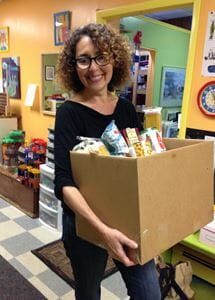Pam Koner

Photos in the New York Times, showing ramshackle houses with dirt floors and children going hungry, changed Pam Koner’s life. She was astonished at what she saw. The photos depicted scenes not from an impoverished country, but from Pembroke, Ill.

“I stared at a photo of a little girl in Pembroke and I couldn’t believe it was a scene from the United States,” says Koner, who had left a 20-year career in the New York fashion industry years earlier to pursue more personally meaningful work. “I literally felt compelled, right then and there, to do something to help.”
In 2003, Koner founded Family-to-Family, an organization based on the idea of providing support to the needy by directly linking families with more to those with less. Koner contacted relief workers in Pembroke, who identified for her the 17 neediest families in town. She then recruited 16 of her neighbors, and together they began mailing monthly boxes of food and personal letters to their sponsored families in Pembroke.
Koner began recruiting new donor families online, and – with the help of extensive national media coverage – the organization expanded rapidly. Over the past 10 years, Family-to-Family has provided more than 1.5 million meals to families in 22 communities in 12 states.
Sponsorship has become easier as the organization has grown and technology has advanced. Individual or monthly donations can now be made online, and food is purchased and shipped locally to recipients.
“Online donations have allowed us to reach a much wider base and eased the traffic of packages mailed out,” says Koner, who operates Family-to-Family as a volunteer from the basement of her house in Hastings-on-Hudson, N.Y. “We now work through the Feeding America Network to identify needy families and link them to sponsors.”
Family-to-Family has expanded its services to include emergency response. In 2005, when the Gulf Coast was struck by Hurricane Katrina, Family-to-Family mobilized its sponsor base to assist more than 1,000 families who were displaced to temporary housing. Donors sent household essentials such as blankets, towels and clothing. Family-to-Family also organized a Christmas drive that provided toys to more than 15,000 children affected by Katrina.
Family-to-Family has also recruited donors to assist hundreds of families affected by Hurricane Sandy in New York. Most notably, the group partnered with Peapod, an online grocery service, to deliver care packages containing food for 16,000 meals, along with cleaning products and other necessity items, to more than 800 families affected by the storm.
Last year, Family-to-Family launched a literacy program to serve low-income families. The group works with the Boys and Girls Clubs of America to identify households with children in need of books. Sponsor families are linked with individual kids and send them one book a month, so that every child served receives a dozen books over the course of a year.
The literacy program includes an innovative project, GivingWorks, aimed at transforming impoverished young people into “givers.” Through GivingWorks, Family-to-Family provides low-income middle school and high school students with backpacks containing books for preschoolers. The older students visit Head Start daycare centers and read the books to the preschoolers, who then receive the books and backpacks as gifts.
“GivingWorks is my personal favorite program,” says Koner, who runs a daycare that teaches creative arts to children. “It has such meaning because these older kids have always been on the receiving end. We’re trying to end that by letting them enjoy the giving experience and understand deep in their psyches that they can be providers.”
